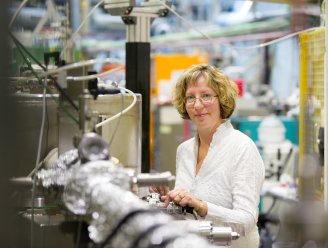Copyright 2012 neutronsources.org | All rights reserved. | Powered by FRM II | Imprint / Privacy Policy

Susan Schorr
Head of Department Structure and Dynamics of Energy Materials Helmholtz-Zentrum Berlin für Materialien und Energie (HZB)
(Information collected July 2019)
Your studies and scientific field:
I am interested in the structure-function relationship of materials for solar energy conversion, such as ternary or quaternary compound semiconductors. These materials, which are used as absorbers in thin film solar cells, contain electronic similar elements like copper, zinc and germanium or light elements like nitrogen, oxygen and hydrogen. Neutron diffraction is very important because it allows to determine the structural disorder and intrinsic point defects, features which crucial influence the optoelectronic properties of these materials. Neutron spectroscopy, especially QENS, gives the possibility to study the dynamic structure and disorder in hybrid halide perovskites, a new class of absorber materials leading to photovoltaic devices with record-breaking power conversion efficiencies.
Neutron-scattering background:
I started with inelastic neutron scattering (TAS) in my PhD at the Hahn-Meitner-Institute Berlin (HMI) and continued in my postdoc with instrument development for time-of flight spectroscopy at HMI and the Los Alamos National Laboratory. Later on in my habilitation I used neutron diffraction to study the crystal structure of compound semiconductors. In 2006 I returned to the HMI, which was named Helmholtz-Zentrum Berlin (HZB) in 2008 and developed the concept for the Neutron Laue Diffractometer FALCON. The wide range of neutron scattering methods always fascinated me and nowadays I like to apply elastic and inelastic neutron scattering methods for my materials research.
Step by step to my position:
I studied crystallography at the Humboldt Universität Berlin. After my PhD in Physics at the Hahn-Meitner-Institute Berlin and the Technical University Berlin I did a postdoc at HMI and the Los Alamos National Laboratory in US. Then I moved to the University Leipzig to do my habilitation and became a frequent user of neutron scattering facilities in Germany, Switzerland, Great Britain and France. I turned back to HMI (now HZB) to became a group leader in the Institute of Technology in the Solar Energy Division of HZB, continuing my research on materials for solar energy conversion suing neutron scattering methods.
In 2008 I was appointed professor at the Freie Universität Berlin where I taught crystallography, X-ray diffraction as well as neutron scattering. In 2013 it became a joint appointment between the Freie Universität Berlin and the HZB. Thereby I got the chance to build up a new department at HZB, which is now the department structure and dynamics of energy materials. Besides our research program my department is responsible for the user service on several neutron diffractometers (the fine resolution neutron diffractometer E9 and the Laue neutron diffractometer FALCON) as well as at experimental stations at HZB’s synchrotron source BESSY II. Thus I am very familiar with three perspectives of neutron research: as a user of neutron instrumentation, as a developer of neutron scattering methods and instrumentation as well as in the responsibility of providing user service on neutron diffraction instruments.
Publications:
Since my PhD I have published more than 200 papers in peer-reviewed scientific journals as well as some book chapters.
Any difficulties because of your gender:
In fact not. Since I grew up in the east of Germany, I was not so aware of gender difficulties. But sometimes I notice the “men’s club”, especially at conferences. I always try to hire the best suitable candidate for a PhD or postdoc position regardless of gender. In my department I have an above-average proportion of female scientists, although I do not consciously prefer to hire women (maybe I invite more than normally). I want to be taken seriously and true as a scientist based on my expertise and knowledge.
Percentage of your time for your family/work/you:
Because I am a so-called single mother it was not always easy to share time between working and family in a healthy ratio. Time for me was and is really scarce. Now my son is a student and I have a bit more time for me. I try to save the weekend completely for the family. And I really try hard not to check my emails during holidays.
Who or what is your mentor/greatest inspiration?
I was lucky enough to have three great mentors on my career path. The first was my PhD supervisor Feri Mezei who introduced me into neutron scattering and magnetism, my habilitation mentor at the University Leipzig who accepted me because of my knowledge in neutron scattering but without a deep knowledge in semiconductors (his expertise) as well as the head of the Institute of Technology of the HZB’s Solar Energy Division who called me when I was working at the University Leipzig to ask me if I would like to join his institute, because he needed somebody to study the crystal structure of compound semiconductors. He introduced me to the technology of solar cells.
Most challenging thing you have faced in your career:
The most difficult time for me was after my son was born. As a single mother without any financial support of the father and without a job (I had just finished my postdoc) I was faced with the challenge to find a new position in science. I was lucky enough to get the possibility to continue my scientific career at the University Leipzig when my son was just two years old. When I came back to the first neutron scattering meeting my old colleagues greeted me as if I had never been away – that was a great moment. And I had always great support from my mother.
One piece of advice you would give to a woman interested in a career in science:
Believe in yourself. You are as good as a man, dare!
Contact details
Prof. Dr. Susan Schorr
Helmholtz-Zentrum Berlin für Materialien und Energie
Department Structure and Dynamics of Energy Materials
Hahn-Meitner-Platz 1
14109 Berlin
Germany
susan.schorr@helmholtz-berlin.de
www.helmholtz-berlin.de/forschung/oe/em/kristallographie/index_en.html